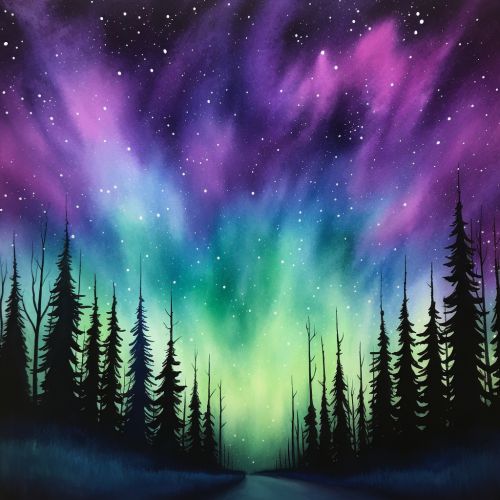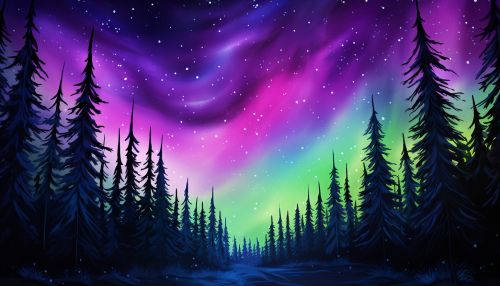Aurora
Introduction
An aurora is a natural light display in the Earth's sky, predominantly seen in the high-latitude regions (around the Arctic and Antarctic). Auroras are the result of disturbances in the magnetosphere caused by solar wind. These disturbances alter the trajectories of charged particles in the magnetospheric plasma. These particles, mainly electrons and protons, precipitate into the upper atmosphere (thermosphere/exosphere).


Formation
The formation of an aurora begins with the Sun. The Sun emits a constant stream of charged particles, known as the solar wind. This wind carries with it the solar magnetic field. When the solar wind reaches Earth, it interacts with Earth's magnetic field, causing a transfer of energy and particles. This process is known as magnetospheric convection.
The transferred energy and particles travel along Earth's magnetic field lines to the polar regions where they increase the energy in the magnetosphere. This increase in energy is eventually released, causing the particles to precipitate into the upper atmosphere. As these particles descend, they collide with atmospheric atoms and molecules, causing them to become excited. When these atoms and molecules return to their ground state, they emit light, creating the aurora.
Types of Auroras
There are two types of auroras - Aurora Borealis and Aurora Australis. The Aurora Borealis, also known as the Northern Lights, occurs in the Northern Hemisphere. It is most visible in the Arctic regions, but can occasionally be seen further south during periods of high solar activity. The Aurora Australis, or the Southern Lights, is the southern counterpart of the Aurora Borealis and can be seen from high southern latitudes in Antarctica, South America, New Zealand, and Australia.
Colors and Shapes
The color of the aurora depends on the type of gas particles that are colliding. The most common auroral color, a pale yellowish-green, is produced by oxygen molecules located about 60 miles above Earth. Rare, all-red auroras are produced by high-altitude oxygen, at heights of up to 200 miles. Nitrogen produces blue or purplish-red aurora.
The shape of the aurora is a direct result of the shape of Earth's magnetic field. In general, the aurora takes on a 'curtain' shape, as the lines of Earth's magnetic field appear as a curtain when viewed from the ground. The aurora can also form arcs that can change shape throughout the night, appearing as quiet arcs or active aurora, which are dynamic and evolve and change constantly.
Viewing Auroras
Auroras can be viewed best at high latitudes during winter months, when darkness lasts longer. However, they are unpredictable and can be seen at any time of the year. The intensity of the aurora is dependent on solar activity, and can range from a faint glow on the horizon to a spectacular, sky-filling display.
Impact on Earth and Human Activities
Auroras have minimal impact on human activities, as they occur high in the Earth's atmosphere. However, they can have a significant impact on systems such as power grids and communications systems that are sensitive to changes in the Earth's magnetic field. This is due to the fact that the same solar activity that causes auroras can also cause geomagnetic storms.
